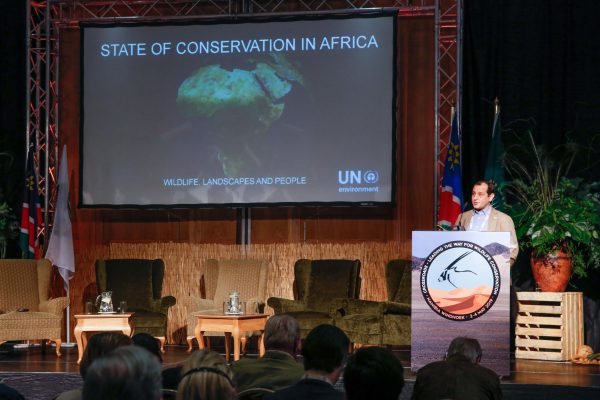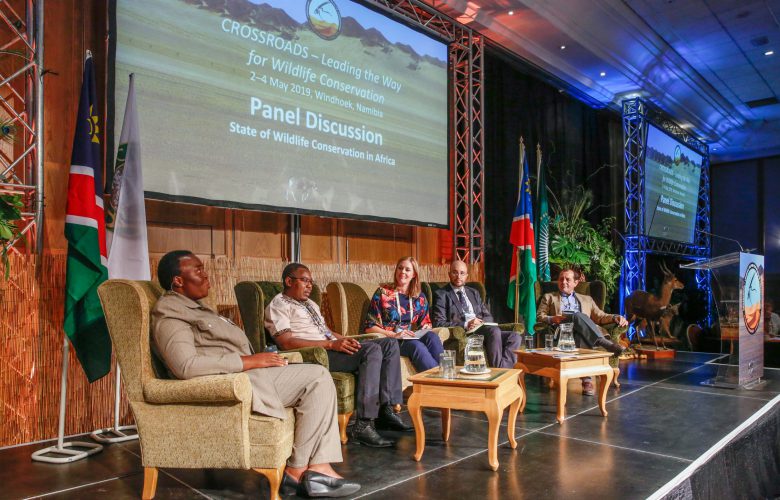Setting the scene for this session was Julian Blanc (Senior Wildlife Programme Manager, Global Wildlife Unit, UNEP), who gave a brief overview of three key elements of conservation in Africa. When speaking on wildlife, it was noted that the IUCN had the most data concerning mammals, due to the interest from hunters. More than half of mammals have Least Concern (LC) status, with 50 species critically endangered, with a similar number of LC ungulates, and a large majority of carnivores with LC listing. It was suggested that the largest threats to wildlife in Africa are actually collateral threats, such as overharvesting, as most mammals and ungulates suffer most from habitat transformation and land use issues. The recent decline in the number of illegal killings of rhino and elephants was also touched upon.
Landscapes and wildlife habitats, specifically changes in land uses, were noted as the biggest combination of threats to wildlife species. The continued changes in land usage are difficult to monitor, as both gains and losses are observed in areas such as forests, grasslands, wetlands, etc. One area where gains can be observed is cropland, due to the expansion of agricultural land by 200,00sq.km in recent years. Despite this, when looking at the net change in land area, there has been a loss of -92,000 sq. km – this can partly be attributed to urban expansion.
The significance of people and their relationship with wildlife was also stressed; people depend on agriculture for survival, and those living in rural communities bear the cost of living in these areas when dealing with human-wildlife conflict. The relationship between wildlife and the health sector in Africa brought up – the variety of dangerous species, population densities and limited access to health facilities are issues have to be addressed.
Rose Mandisodza-Chikerema (Chief Ecologist, Zimbabwe National Parks, Zimbabwe) gave her opening remarks regarding her vision for rural communities in Africa. As these individuals are the primary stakeholders when it comes to wildlife conservation, they can have a significant impact if more work is done to involve them in wildlife related matters.
Johnson Ndokosho (Deputy Director Central Regions, Ministry of Environment and Tourism, Namibia) gave a statement on the Namibian perspective, and whilst they wish to see nature being conserved, it is important to see that natural resources are not depleted when implementing sustainable use. Conservation and wildlife use has seen a massive increase, and with it comes the need for progressive policies to address human-wildlife conflict. In addition, strategies will need to be implemented to address concerns such as feed shortages in the event of droughts.
Moving on to the panel discussions, panelists were asked to describe the different approaches to wildlife use across Africa. The vastly differing attitudes of Southern Africa, which promotes sustainable use, and Northern Africa, which do not touch or use wildlife, was highlighted. The results of this speak for themselves, as Northern areas have seen the loss of much wildlife. CBRNM though conservancies, and the model for deriving benefits from wildlife in Namibia, was given as an example of a working, successful model for sustainable use.
The topic of sustainable use, and persuading other nations of its application, was then posed; the need to meet with a common position for CITES was underlined, as there is currently no consensus at the African level. This means building mechanisms to work together, as well as the sharing of information. Support for countries that host iconic species will also be key, as well as challenging those who come up with decisions that are not progressive. There should be a limit on restrictions to the use of wildlife for private land owners, as this is the only solution for people that live in areas with animals.
Panelists were then asked which strategies could be used to stop the narrative that hunting has a detrimental impact on local lives. It was argued that hunters should take more responsibility to inform others of the benefits of wildlife use, such as the distribution of meat to communities and schools. Namibia should be shown as a case study in the implementation of conservation, as their approach has benefited many communities living in conservancies and has limited the influence of corruption within the state.
The final question, Would Africa without certain NGOs reach consensus on certain mechanisms for conservation, gave some strong responses on the influence of external forces in Africa. West and East Africa do not support the South, and believe that international conventions are the solution to the wildlife problem. It is argued that this is not the correct approach, as groundwork and an overall consensus is the way to make progress. The giraffe listing in CITES was given as an example, where the population increased in South Africa but saw a decline in numbers everywhere else. Simply going to CITES and listing the species was not enough to enact significant change.

